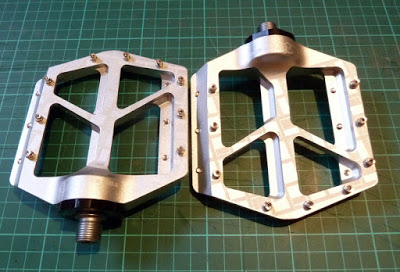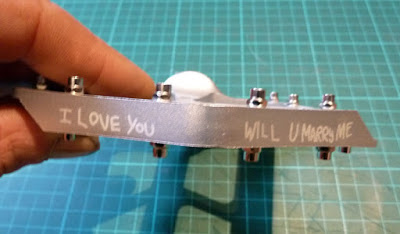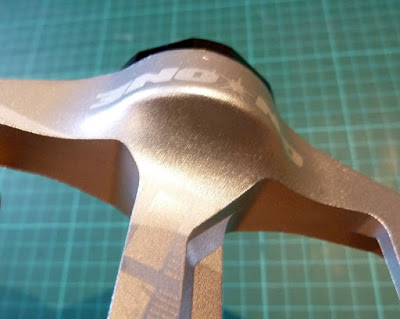Pedals? Clipless or flats? Flats or clipless? It’s a question that has no answer because whatever answer you receive, will be born largely from personal preference, half truths and mis-guided good intentions. There’s simply no right or wrong answer … if there was, I’m sure people would have stopped asking by now. If your foot’s firmly held in the clipless camp then it’s unlikely you’ll find what I’m about to write of any interest, so feel free to click elsewhere. However, should your feet attach to your pedals by non-mechanical means, then read on.
The design of a flat pedal will greatly effect how well it carries out its duties. As with many things, there are aspects of design that are highly desirable but sadly, not always possible. Usually, that means sacrificing one for another and hopefully producing something with the least possible amount of compromise and deviation from the ideal … the On-One ‘Park Hill’ seems a lot closer to the ‘ideal’ than many.
 |
| Thin, grippy and light – what else do you want? |
Size – Having a decent sized platform on which to place your foot is a prerequisite. Obviously ‘decent size’ is difficult to define, too small and your foot won’t feel secure but too big and you’ll increase the potential for pedal strikes and general clearance issues. The platform on the Park Hill is a generous 100mm front to back and 90mm axle to outer edge.
Shape – The 100mm x 90mm platform is quite a substantial area for a shoe / pedal interface and large enough to raise a few eyebrows from those concerned about clearance. Usually manufacturers get round any concerns by reducing the thickness of the pedal but this isn’t without its issues and the problem lies with the axle. Let’s imagine a pedal with a 12mm axle, in the good old days the pedal body would probably be around 25mm thick. This extra material allowed the manufacturers to add a little shape to the pedal in the form of a concave platform. This concave was good … it helped to stabilise your foot and naturally pushes the foot into the pedal. You know there’s a ‘but’ coming now don’t you? So, here it is – but the thicker pedal limited the platform size to a degree as it reduced ground clearance and also produced a less stable pedal and one more likely to ‘roll’ beneath your foot. Reducing the thickness not only helped eliminate these problems but it also helped lower the riders centre of gravity a little … and here’s your second ‘but’ … but in the search for the thinnest possible pedal, the axle eventually became the thickest part. The ability to incorporate a concave in the platform was lost and in many instances pedals actually started to become convex in shape.
 |
| No, I’m not sure about this either – suggestions on a postcard please. |
So, what do we want? Well, ideally we’d like the thinnest pedal possible that still has a convex shaped platform. Is this possible? I hear you asking. Yes, it is but up until recently you required deep pockets if you wanted to actually eat your cake. The Park Hill manages this feat by removing the majority of the troublesome axle. Rather than a continuous axle running through the pedal body, the Park Hill uses a short ‘stub axle’. With most of the axle gone, you’re free from any design restraints it inflicted, so in this case, we have a very thin pedal (it’s only 10mm thick) that also features a subtle concave … it’s the essence of ‘win win’.
Weight – I feel that if I didn’t mention weight, then I’d be neglecting my duties – after all, this is a bikepacking website. Flat pedals aren’t usually known for their lightweight characteristics but at just 217g a side, the Park Hills are almost feathery. In fact they’re about half the weight of most pedals and still weigh considerably less than those sporting magnesium bodies and Ti axles.
 |
| Bearing and axle all housed in here. |
Grip – With nine replaceable pins each side and the subtle concave already mentioned, grip really isn’t a concern. The reality is, that if you find your feet slipping off these, the problem doesn’t lie with the pedals or your choice of footwear but with your foot placement and technique.
The pedals pictured don’t look quite as sparkly new anymore, they’ve now got a slightly muddy patina after their maiden voyage … I’ll report back before too long and let you know how their coping with what the weathermen laughingly call winter, maybe they’ll be light enough to float?
Park Hill Flats, £29.99 – £49.99 from On-One
Suddenly realised the source of the name – https://en.wikipedia.org/wiki/Park_Hill,_Sheffield Only a couple of miles from On-One HQ
…and the message on the pedals is inspired by graffiti from the flats.
Ah and a pleasant example of the vandals craft it is … I'm sure there were far worse things they could have picked ;o)